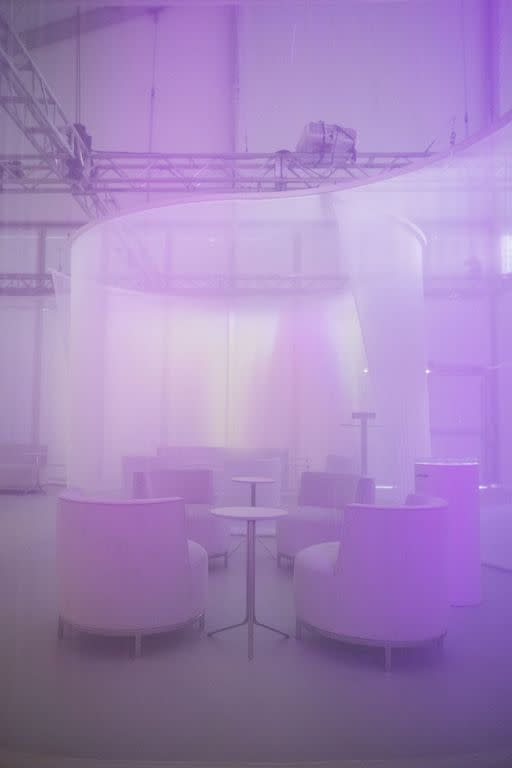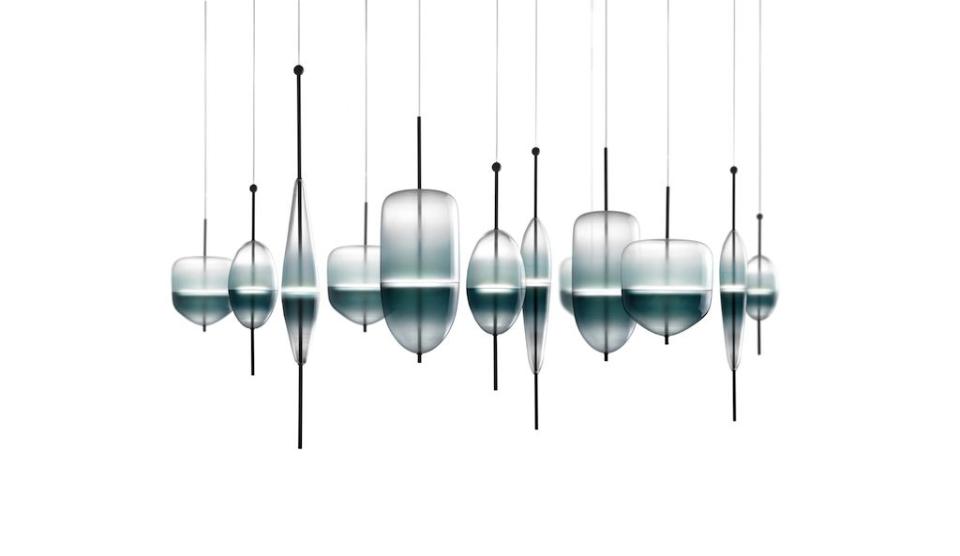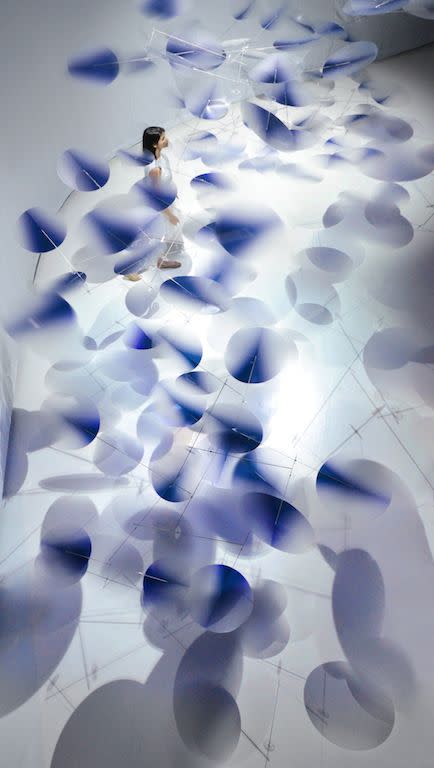You Have to See The Sunshower Installation Designer Nao Tamura Created for Design Miami

Visit enough design and art fairs and it can sometimes feel like certain exhibitors are competing in a game of maximalist one-upmanship with their attention-getting installations. Designer Nao Tamura’s creation for the Lexus booth at last week’s Design Miami/ (the automotive company was a partner for the second year in a row) offered a delicate about face to such displays. Keeping with the fair’s theme of “Elements: Water,” Tamura’s design, entitled Sunshower, brought to mind a rainbow ombré meditation room, at once futuristic and of-the-moment. It also dovetailed neatly with the Lexus LC Convertible Concept car on display, melding as it did the beauty of nature with the pleasures of interior design.
Based in New York, Tamura was born and raised in Japan. She studied at Parsons School of Design and her practice combines industrial design and one-off products for brands like Issey Miyake, WonderGlass, and Artek. We caught up with Tamura at Design Miami/ to chat about her Sunshower installation and the balancing act of her work.

What did the Design Miami/ curatorial director Aric Chen and curator Maria Cristina Didero propose to you when they approached you about working on the Sunshower installation?
They already had the theme Sunshower, as well as a brief story behind it. For creative people, you can say it’s easier to have that or maybe it’s a little bit harder because you have to follow them. My role was to visualize their story through my cultural lens of Japan. But I was fascinated when they told me about the story because it was pretty much based on Japanese tradition and culture.
In what way?
They had Japanese keywords, omotenashi and engawa. So omotenashi is a Japanese tradition of hospitality. Omote means your public face. And nashi means nothing. So that means there is no business face to serve you, it should come from the heart. That’s why this year Lexus wanted people to use the installation space to relax, to rest. An art fair can be very chaotic. So we have charging stations, we have [edible water droplets called Ooho by Notpla]. And engawa is like a little deck in a traditional Japanese house that’s going to be connected to the inside. And usually it’s divided by Shoji screens. I wanted to use the screens to express that. And when the weather is nice, people will sit on the deck. The engawa concept is the place people will gather, so it connects people and brings the outside inside. That applies to the convertible car: you’re driving inside, but you’re outside.

And the lighting and the color change, how did you come up with that?
It’s a projection of clouds and rain. When I heard the word sunshower, what I envisioned was not a still image. A sunshower is grey and then it turns to sunshine and the clouds move in…it’s a dynamic movement. I wanted to capture that in this projection. It’s like what you experience when you’re in a car. The scenery changes.
Is video projection something you’ve worked with in your other projects?
It’s actually my first time. Hiroshi is the motion animator. He’s based in Japan. I worked with him and he visualized the concept. I normally don’t use something virtual; I’m more into the natural reflection. It was a challenge, but I would say it opened the door that I never really opened. I can still make it very organic. I’m hoping that the collaboration with Lexus has been as technically accurate as it can be, but I left room for nature to take its place. There’s a lot of things you can’t control, like the sunlight [coming into the tent]. But that’s okay. Lexus design is very precise and perfectly placed. My approach is a little more organic, so I was hoping the chemistry through the very different approaches will make something really amazing.

You mentioned in the beginning that you were bringing design through a Japanese lens. But you also went to Parsons and you’ve been living in New York since then. And you’ve spent more of your life in New York than Japan. Do you consider yourself design-wise part of a Japanese culture? Or are there ways in which you are more New York?
Sometimes you step out of where you are and you see it better and you appreciate it a little bit more. The fact that I’m outside of Japan, I think I respect it more than I used to, the culture and the tradition. I’m a little more of a New Yorker because I’m based in New York and my approach, the way I communicate with people is not very Japanese. I always like harmony. I like the balance between East and West. I can be very technical—I can be a control freak. But I want to keep the organic-ness, too. That balance is very important. The function and the emotion—I think the product has both qualities. My private life and work have to have a harmony. Otherwise, if I step into one side too much, I lose balance. So the fact that I’m born in and grew up in Japan and my life is in New York, that harmony is great.
What made you decide to study design in New York instead of Japan?
There was a sister school to Parsons in Japan and my uncle was the dean. And so I had that path to come here. I feel like New York City lets me be myself. I don’t need to be pretending to be somebody. Industrial design, this world is still very man-driven. Maybe the arts is different, but industrial design has a lot of male designers. And when I was applying for a green card, I was in Japan for three years and I was working there for the first time. And it was not easy.

This was after you graduated from Parsons?
There’s a design firm called Smart Design [in New York]. I worked for them for five years. After that, I wanted to be independent, so I applied for a green card. That was after 9/11. So it took longer. And I was in Japan and experienced what it’s like to be an independent female designer in Japan. And I was in my 20s and I was not established. But it was not easy. New York is the kind of place that lets me by myself. It’s important for me to be here. It’s very close to Europe and I get a lot of Japanese clients even being based there.
A good majority of your work is industrial design?
I would say my projects are pretty diverse: Installations that are large scale like this and then I recently launched a watch with Issey Miyake and that scale is very different. I don’t put it in my portfolio, but I do a lot of high-tech products like cellphones and laptops in Japan for companies like Panasonic. They pay well. But sometimes creative jobs don’t pay much. That’s the balance, again.
Your father is a designer and you have other family members also in design.
My mom is an interior designer. My grandmother was a fashion designer. And my aunt is also a fashion designer. And my uncle is a graphic designer. And my other uncle is an interior designer. It’s a strange, creative family.
Was it obvious you’d be designing in some capacity?
I wasn’t a good student. I was awful with math. I was bad with writing. All I was good at was art and sports.
Which sports?
I swam, played basketball. But that was it. So it was a pretty obvious. You know some people are very good at everything and they have a hard time choosing? I was like, alright!
Did you ever think about fashion or interiors?
I’ve never been interested in fashion. I don’t know why. Design to me is a tool to communicate. For example, this time it’s Lexus. Sometimes I feel like I’m a translator. They have their idea, philosophy, and something they want to communicate with the audience, but they don’t know how. So I’m translating. I listen to them and I visualize it so that it expresses what they really want to do. The outcome could be a space like this. It could be a watch. It could be lighting. It could be anything. For me, it doesn’t really matter. It’s more the story and what’s inside.
You Might Also Like

